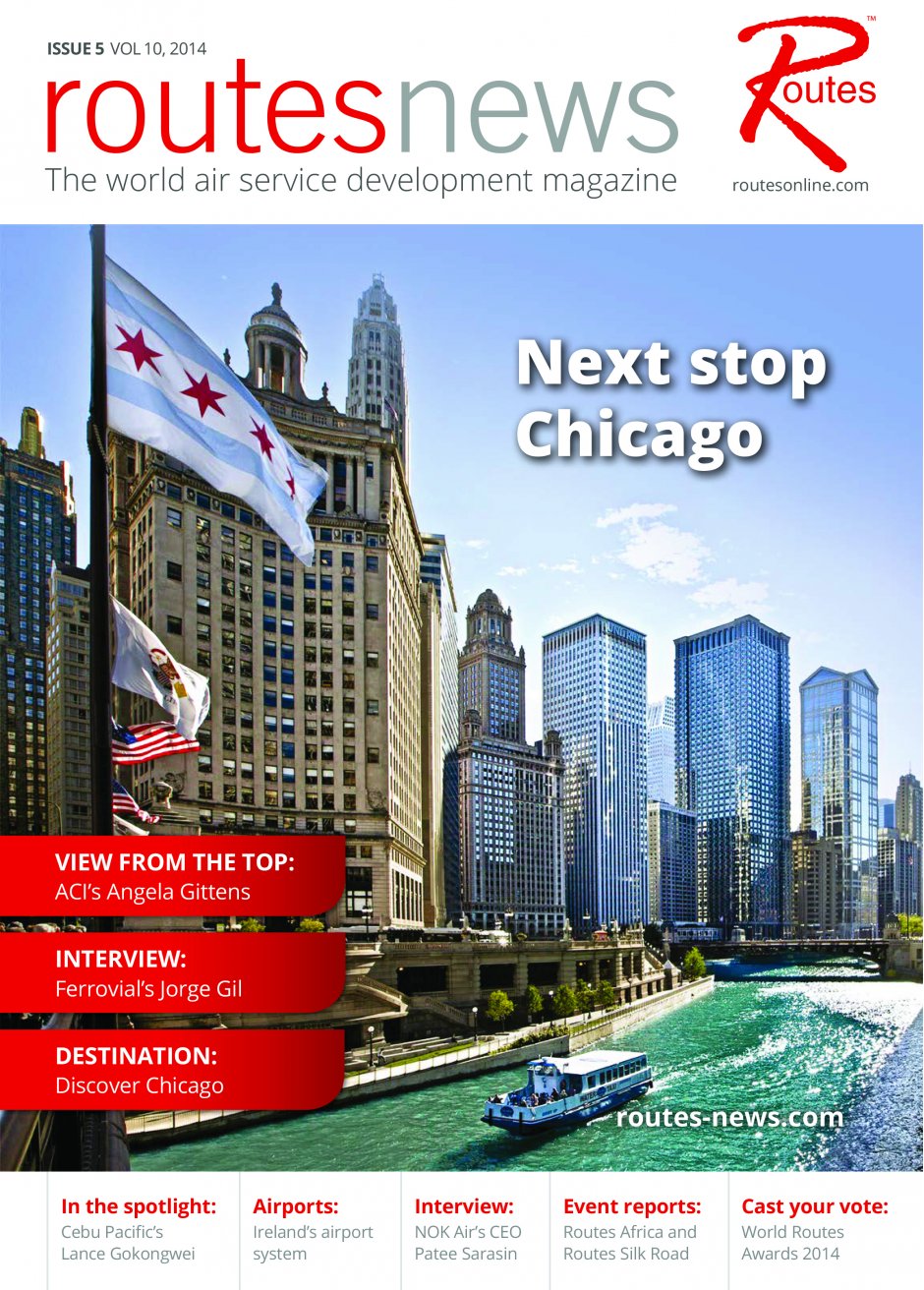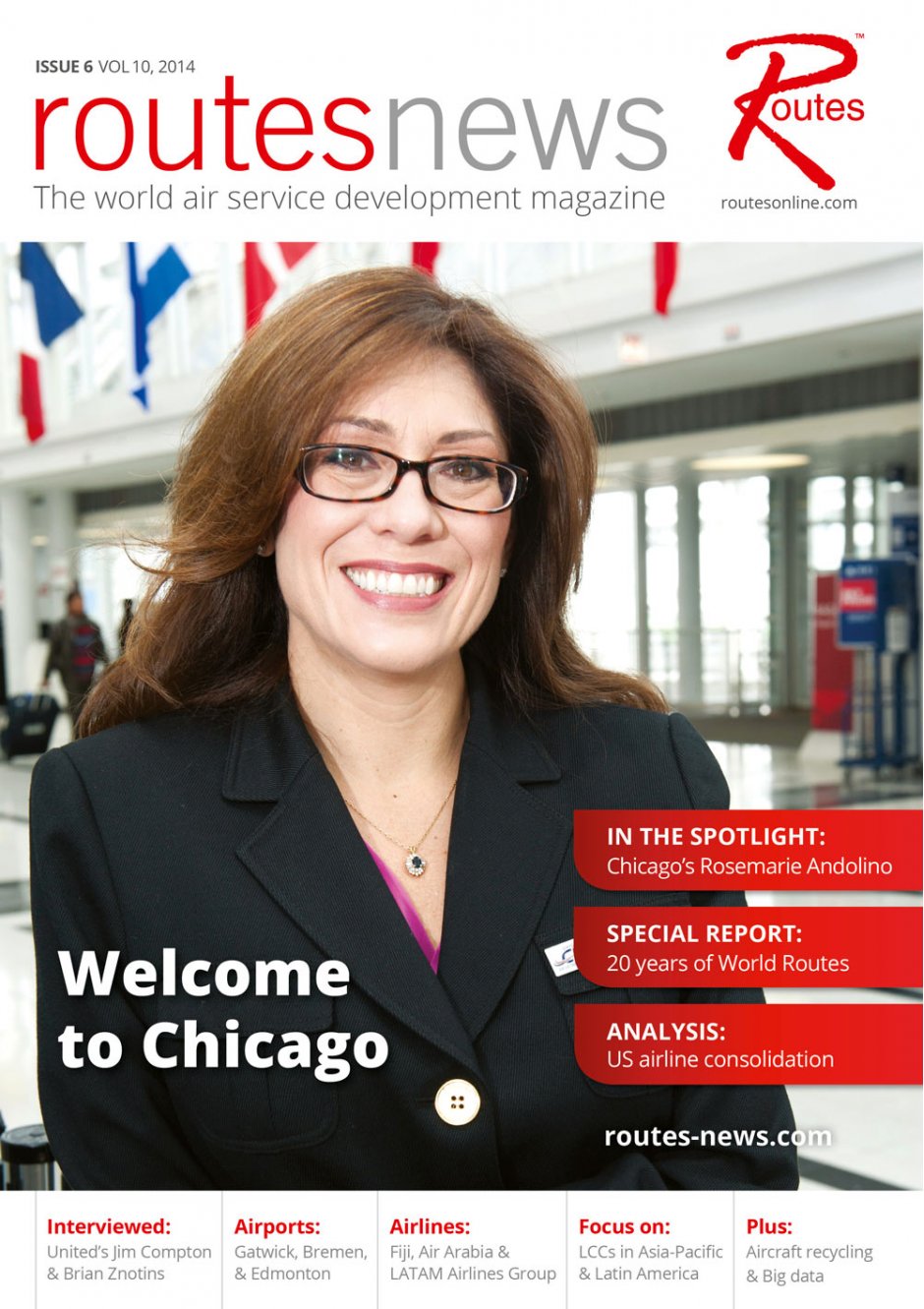When you talk to Rosemarie Andolino about the highlights of her five years in charge of Chicago’s airport system, the subject of route development is right up there. Indeed, the commissioner of the Chicago Department of Aviation (CDA) has no hesitation in admitting that attending World Routes in Vancouver in 2010 was one of the best things she did as it proved the catalyst for a new route development strategy.
That strategy has since led to the most productive period in Chicago’s history in terms of the launch of new routes and frequency increases. Yet it could have been so different, because Andolino says that she might never have heard of the event if a colleague hadn’t persuaded her to go to World Routes five years ago.
“It sounded interesting, so I decided that we would attend, and it turned out to be one of the most valuable business-to-business meetings we’d ever had. In fact, I was so impressed that, on the flight back to the US, I decided that I wanted to bring World Routes to Chicago,” she says.
What was so impressive? Andolino says the ‘speed dating’ aspect of the event was particularly rewarding as it proved to her that the CDA had to do much more than just show “pretty postcards of Chicago” to airlines to get them to launch services to O’Hare or Midway. She explains: “During the speed dating meetings, I basically asked people two questions – had they ever been to the US and had they ever visited Chicago?
“I found out that the majority of people had visited the US, but very few had been to Chicago and, worse still, it wasn’t even on the radar of most. And these were the airline people directly responsible for launching new routes! It was time to be more proactive,” she adds.
Andolino actually cites the launch of Etihad services (Abu Dhabi) in 2009 – a year earlier than World Routes in Vancouver 2010 – as the start of the current ‘golden years’ of international route development for O’Hare. She notes that Qatar (Doha) followed in 2013 and the addition of Emirates (Dubai) in August 2014 gave O’Hare the full set of big Middle Eastern carriers.
Other additions under Andolino’s leadership include Cathay Pacific (Hong Kong); Copa (Panama); Air India (Delhi); WestJet (Calgary and Vancouver); airberlin (Berlin); Austrian Airlines (Vienna); Hainan Airlines (Beijing) and Volaris (Guadalajara; Morelia, Zacatecas, León); while Spirit has trebled its operations into Chicago.
And crucially, each new air service has brought huge economic benefits to the Windy City, says Andolino. “When we talk about airports as economic engines, depending on the size of the aircraft and the destination, a new route could add anything from $20 million to $200 million of investment per annum into your city,” she enthuses. “In total, we have added over $3 billion worth of new services per annum to Chicago in the past five years and this is something I am particularly proud of.”
Andolino says that her “game changing” visit to World Routes in Vancouver triggered a total rethink in the CDA’s strategy when it came to the business of air service development. Gone were the days of waiting for airlines to make the first approach and a new proactive era of route development was born based on aggressively going out and looking for new business.
Airline mergers and acquisitions and the rise of carriers in emerging markets, has created a very different, more transparent and competitive environment today in terms of route development, notes Andolino. And she insists that the winners in this market are the airports that do the maths and have solid business cases to take to the airlines.
Under its new air service development strategy, she reveals that the CDA now openly “courts” airlines it wants to attract to either O’Hare or Midway, and hosting World Routes in Chicago this September is very much part of that process. “Five years ago the philosophy was very much ‘we are O’Hare, they will come.’ Not any more. Times have changed and we have to go out and get them,” she explains.
“In my opinion, there are a limited number of aircraft entering the market at any given time, and I want them to choose Chicago first. It’s important that we develop a relationship and trust with the airline, and present it with a solid business plan. We do our homework and are now in a position to show airlines information and numbers about the potential of new routes that maybe they don’t know or are unaware of as nobody knows Chicago or this market better than myself and my team,” she says.
The CDA’s ambitious route development philosophy is in line with Chicago Mayor Rahm Emanuel’s target of growing international tourism to 55 million visitors by 2020 – the bulk of them arriving via O’Hare or Midway. So the CDA obviously boasts a huge route development team, right? Andolino laughs out loud, before chuckling: “The truth? It is only a handful of people. We have a very lean and effective team.”
Route success can take years to accomplish, often involves dozens of meetings and might mean multiple overseas visits for Andolino and Matt Danaher, the CDA’s director of marketing and route development, but the financial rewards to Chicago, as she outlined earlier, are colossal. “Every new flight brings money to Chicago, provides more choices for passengers, creates new jobs and improves the city’s connectivity to destinations around the world. Everybody wins,” she smiles.
Between them Chicago’s airports handled a total of 87.3 million passengers in 2013 and the upturn has continued into 2014, with volumes up 4% at O’Hare and 2% at Midway in the first five months of the year. O’Hare, the city’s main international gateway, accounted for 66.9 million passengers (+0.4%) and Midway – which essentially handles domestic services and international flights to Canada, Mexico and the Caribbean – accommodated 20.4 million passengers (+5%).
The difference in traffic is down to the fact that Midway is built on a site of just one square mile and the 6,500ft (1,980m) length of its longest runway is not enough to accommodate non-stop flights to long-haul destinations. It does, however, handle regional traffic, with airlines such as Volaris and Porter Airlines serving Mexico and Canada respectively, and Southwest Airlines serving Mexico, the Dominican Republic and Jamaica. As a result, Automated Passport Control (APC) kiosks were installed at Midway this spring to make it easier for US citizens on international services to pass through its facilities.
Andolino believes that having two hub carriers (United and American) at O’Hare and Southwest growing and adding new routes out of Midway already gives Chicago outstanding connectivity across the globe. She says that it is amazing how many places in the world can be reached with a single flight from O’Hare or Midway, and states that all the major US airlines – with the exception of Hawaiian – and most of the world’s major airlines serve Chicago.
However, Andolino is anxious for more and tells Routes News that there is definite room for growth in air services to Africa, China and Latin America. Although O’Hare already has direct services to the Chinese cities of Beijing, Shanghai and Hong Kong, she believes that the business links between the US and China would support new services to cities such as Tianjin, Shenyang, Qingdao, Hangzhou, Wuhan and Chengdu.
Indeed, her self-confessed desire for more services is one of the reasons behind her wish for Chicago to host World Routes this September. “There is no denying that the competitive nature in me wants more routes, and I of course relish the opportunity to showcase our amazing city to the world,” says Andolino.
Andolino worked in various positions for the City of Chicago from 1990 onwards and served as first deputy commissioner in the city’s Department of Planning and Development (DPD) before Chicago Mayor, Richard Daley, appointed her executive director of the O’Hare Modernization Program (OMP) in 2003.
The role put her well and truly in the spotlight, with some questioning her suitability to oversee the $8 billion OMP, despite the fact that as first deputy commissioner with the DPD she managed a $35 million budget, oversaw $100 million of land acquisition and capital investments in the Neighborhoods Alive Program, and helped secure state and federal funding for numerous city projects.
She proved her critics wrong by successfully working with federal, state and local officials to secure OMP funding. Indeed, in November 2005 the then-US Department of Transportation Secretary, Norman Mineta, travelled to Chicago to approve the city’s request for more than $300 million in federal funding. And since then the OMP has raised more than $5 billion through the sale of bonds and received approval for four Passenger Facility Charge applications by the FAA to fund design, construction and land acquisition.
Under Andolino’s leadership, the OMP also created the Sustainable Design Manual (SDM), a nationally recognised document that has allowed O’Hare to become the benchmark for environmental stewardship in design and construction for a civil project. The SDM has since evolved into the Sustainable Airport Manual (SAM), which provides guidance for sustainability across all airport functions, including concessions and tenant activities.
The successes led to her being appointed commissioner of the Chicago Department of Aviation (CDA) in February 2009 and arguably acted as the catalyst for one of the most successful periods in the history of O’Hare and Midway. “If you think of the runways we’ve built ahead of schedule and under budget; the complete transformation of Terminal 5 at O’Hare; traffic growth; record revenues; the installation of the first Automated Passport Control kiosks in the United States; and the fact that times have never been so robust in terms of new air services, I think my record holds up pretty well,” she says.
Andolino could also have mentioned the significant strides Chicago’s airports have taken to embrace environmental best practice and improve their customer service levels, or the image-enhancing upgrades to the domestic terminals that have included, and that still continue to incorporate, the introduction of a number of new concession concepts. She quips: “I may not have grown up in the aviation business, but I’ve grown up in the business of getting things done.”
There is certainly no doubting that when Andolino walks out of the Chicago Department of Aviation’s office for the last time later this year, O’Hare and Midway will be losing one of their biggest supporters. A local girl – she grew up in Elk Grove Village just west of O’Hare – Andolino admits that she has always been a fan of the Windy City’s airports, so the chance to help develop them, firstly through her leadership of the OMP and then as commissioner, were opportunities she says she simply couldn’t turn down.
And she certainly couldn’t be accused of sitting back and taking it easy as under her leadership the city’s gateways have undergone somewhat of a transformation in terms of new infrastructure, profitability and pioneering environmental initiatives. Her passion for the job is clear So what has it felt like to be the boss of one of the world’s biggest airport systems for the past five years?
“It’s been exciting, a learning experience and an amazing ride,” enthuses Andolino, who is stepping down to pursue a new challenge in the private sector after 24 years in local government and 11 years in aviation. Has being a local girl made it even more of an honour? “Absolutely! My focus was to take two great airports and make them better, and I genuinely believe we have done that over the past five years,” she says. “I love this city and want to make sure that others get the same great experience that I’ve had growing up here.”
 |
This article originally appeared in our sister magazine, Routes News. DON'T MISS the latest issues of Routes News which are available at this year's World Routes. |
 |
